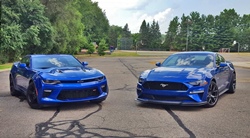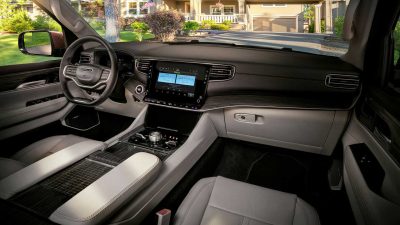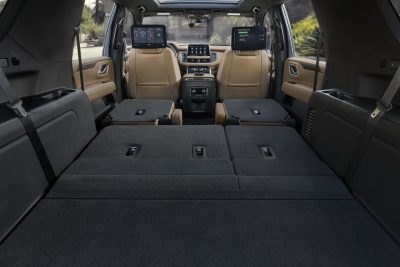When we last checked in on the 2022 Jeep Wagoneer lineup, we put it side by side with the Ford Expedition to see how the Wagoneer would do in a figurative matchup amongst customers. While we still have to wait a while to experience it formally, we wanted to go ahead and do a small sequel. Still, this time pitting the revived icon against the Chevrolet Suburban to see which would stand out in the battle to grab the attention of family buyers.
Wagoneer Styling Has A Leg Up On The Bow Tie Brigade
Looking at the exterior styling of the two and the Jeep’s combination of retro flair and futuristic substance is immediately apparent. To keep things fair, we chose to leave the flashier and pricier Grand Wagoneer out of the fun this time and instead focused our attention on the mainstream Wagoneer family. While this means you lose some of the chrome appointments and the novel lighting elements, the Wagoneer still oozes class. From the powerful upright-shaped grille to the large slab sides, the Wagoneer has no problem flaunting its size to the world. The rear styling is bland, but we’ll give Jeep a pass here since the taillight design does make up for this somewhat.
In contrast, the Suburban seems like it was designed with a bit too much restraint. While part of this is due to GM preferring to leave the eye-catching styling to the Yukon and the range-topping Escalade, the Suburban feels like it’s hesitant to step out of its comfort zone. The front fascia is an improvement over the outgoing model, but the rest of the Suburban doesn’t leap out and scream for attention. That’s a shame, especially since the segment that the Suburban competes in is very crowded and anything that can help draw the attention of style-focused buyers is a major plus for any full-sized SUV.
Two Interiors One Outcome
While the exterior is one part of the equation, it’s ultimately the interior that plays a prominent make-it-or-break-it role in any SUV purchase. Here in this arena, the two are on a more even playing field, with both the Suburban and the Wagoneer playing to their respective strengths. The Wagoneer stands out like a wily gambler by going all-in on quality. Leather seating is standard on all trims, and the dashboard has a strong mixture of retro and modern themes. That includes the real wood trim and even some of the high-quality plastics that make their own lasting mark in viewers’ eyes.
While the cabin does not have some of the wiz-bang gadgetry that defines the Grand version, that doesn’t mean that the technology side of the coin was forgotten about. A 10.1-inch infotainment system is available, and it even comes equipped with Uconnect 5, which is an excellent interface in its own right. As for the 2021 Chevrolet Suburban, It can be equipped with a slightly larger 10.2-inch infotainment screen. It uses the latest version of MyLink, which has had some time to benefit from various updates. While MyLink is not quite as slick as Uconnect 5, it’s a proven system, and that might give it an advantage against the Jeep’s unit, which is still a young software suite.
So how do they measure up when it comes to the matter of hauling people and cargo? The Suburban certainly puts on a strong showing, with the big Chevy offering 41.5 cubic ft of space with the seats up. Fold all two rows of them down, and you are rewarded with 123 cubic feet of space. That’s slightly higher than the Jeep’s 117 cubic feet, but that’s partially due to the Suburban using an independent rear suspension which freed up the space taken up by its old solid rear axle.
Eight Cylinder Mortal Combat
Unlike the Ford Expedition’s all V6 lineup, the war of performance between the Wagoneer and the Suburban is largely fought by V8 engines. A 3.0-liter diesel engine is available on some Suburban trims, but in the interest of fairness (as well as projecting what customers will gravitate to at dealerships), the oil burner gets to sit on the bench for this one. The Suburban’s 5.3 liter and 6.2-liter V8 engines might seem like they were merely carried over, but both of them have actually benefitted from some minor updates that help improve their game slightly.
The 5.3 liter is the volume-focused one and makes 355 horsepower with 383 lb-ft of torque on hand for serious towing work. The 6.2 liter V8 makes 420 horsepower, but it’s only available on certain trims and cannot be equipped to lower grade Suburban trims.
As for the Wagoneer, it’s powered by a 5.7 liter Hemi that’s certainly been around the block quite a few times and, in some regards, is just as old as the Suburban’s engines. The engine is still handy, though, and in this instance is also paired with a 48-volt mild hybrid system. Jeep claims the combination allows the Wagoneer to produce 392 horsepower and 404 lb-ft of torque, putting it in the running with its domestic rival. The Jeep does lose two cogs to the Suburban’s 10-speed automatic, with all Wagoneers being equipped with an eight-speed automatic. A more powerful 6.4 liter V8 is available, but you have to upgrade to the Grand Wagoneer to take full advantage of its beefier power.
That muscle also helps the Wagoneer best the Suburban in towing with the Jeep’s 10,000 lb towing limit trouncing the Chey’s max rating of 7,800 lbs. That extra wiggle room allows the Wagoneer to tow some truly massive loads and is a reminder of just how strong the old Wagoneer was in that particular arena.
Which One Is Right For Your Budget?
A key part of any full-size SUV is its ability to cater to the budget of a family buyer. The Wagoneer comes with more standard equipment, and while it’s a bargain compared to the Grand Wagoneer, all of that standard fare comes at a price with the base Series I model starting at $59,995. That’s $3,000 more than a base $56,995 Suburban LS, which prefers to focus on value-focused equipment delivery. A lone caveat here is that Series I will not be available at launch, with the Series II and Series III models making up the first wave of shipments.
Those two have starting prices of $69,995 and $79,995, respectively, and target both the LT and the Premier models in price. Series III, in particular, is also a potential threat to the range-topping High Country model. However, the biggest departure here will be how Jeep will be handling Wagoneer orders through the entire buying process. Like Land Rover and some other high-end luxury brands, Wagoneer will have specially trained sales personnel with a strong emphasis on using mobile technology to explain various aspects of the vehicle and using several pillars of service to help achieve this goal. In contrast, Chevrolet is taking a more mainstream approach with the buying process for Suburban. Still, GM is exploring ways of enhancing the buying experience for Suburban owners, and some of the local dealerships we talked to are enhancing the way they promote the Suburban.
At the end of the day, both the 2021 Chevrolet Suburban and the 2022 Jeep Wagoneer are very potent entries in the full-size SUV segment that aim to achieve different goals. The Suburban aims to continue its reign as Chevrolet’s cash cow while the Jeep aims to redeem itself for the ill-fated and under-engineered Commander. We look forward to seeing how the two square up when the Wagoneer formally enters dealer inventory, and we’ll gladly sit back with a bowl of popcorn and see this matchup unfold.

Carl Malek has been an automotive journalist for over 10 years. First starting out as a freelance photographer before making the transition to writing during college, his work has appeared on numerous automotive forums as well as websites such as Autoshopper.com.
Carl is also a big fan of British vehicles with the bulk of his devotion going to the Morgan Motor Company as well as offerings from Lotus, MG, and Caterham. When he is not writing about automobiles, Carl enjoys spending time with his family and friends in the Metro Detroit area, as well as spending time with his adorable pets.











